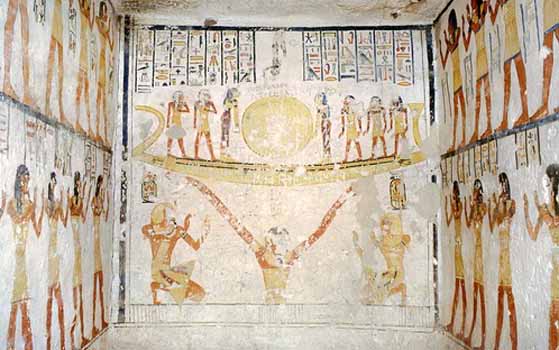The Ogdoad, an ancient group of eight primordial deities, played a foundational role in Egyptian cosmogony, symbolizing chaos and pre-creation forces. Worshipped in Hermopolis, they represent key elements like water, infinity, darkness, and hiddenness. These forces later influenced the emergence of more defined gods, such as Ra and Amun, who organized chaos into divine order. The Ogdoad’s themes of chaos, rebirth, and transformation shaped Egyptian religious thought, influencing creation myths and the balance between order and chaos, light and dark, and life and death.
Introduction to the Ogdoad
The ancient Egyptian pantheon is vast and complex, filled with deities that governed every aspect of life, death, and the cosmos. At the core of Egyptian cosmogony lies the Ogdoad, a group of eight primordial deities worshipped primarily in Hermopolis, whose concept predates many of the more well-known gods such as Ra, Osiris, Isis, and Horus. The Ogdoad, symbolizing the pre-creation forces, played a foundational role in shaping the religious and mythological framework from which the later Egyptian gods emerged. Understanding their role offers key insights into the evolution of Egyptian religious thought.
Who Are the Ogdoad?
The Ogdoad consisted of four male-female pairs of gods, each embodying a cosmic principle or element necessary for creation:
- Nun and Naunet – Representing the primordial waters.
- Heh and Hauhet – Symbolizing infinity or boundlessness.
- Kuk and Kauket – Personifying darkness.
- Amun and Amaunet – Embodying hiddenness or the invisible forces.
These deities were often depicted as anthropomorphic figures with frog and snake heads, representing their elemental and chaotic nature. Together, they personified the chaotic and formless universe before the emergence of order and life. This primordial state, known as Nun, is described as a dark, watery abyss from which creation was birthed.
The Transition to Later Deities
As Egyptian mythology evolved, the Ogdoad’s abstract, formless deities gave way to more defined and anthropomorphic gods. While the Ogdoad represented the chaotic potential of the universe, the later deities emerged as the organizers of that chaos, responsible for maintaining Ma’at (the divine order).
- Ra (or Atum) emerges from Nun in some myths, symbolizing the dawn of creation. In this sense, Ra or Atum can be viewed as the culmination of the Ogdoad’s creative potential, the divine spark that brings light and order to the primordial darkness.
- Amun, originally part of the Ogdoad, rose to become one of Egypt’s most powerful gods, especially after the Middle Kingdom, where he merged with Ra to become Amun-Ra, a supreme deity embodying both the visible and hidden aspects of existence. His earlier association with hiddenness in the Ogdoad provided a metaphysical background for his later role as a king of gods.
- The themes of creation and transformation represented by the Ogdoad also find resonance in the mythologies of Osiris and Isis. The Ogdoad’s concept of chaos, darkness, and water as necessary precursors to life finds echoes in the Osirian myth, where death (chaos) is a precursor to rebirth and regeneration, especially in the annual flooding of the Nile, which was vital for Egypt’s agricultural life.
Influence on Cosmology
The cosmological framework established by the Ogdoad continued to influence later theological developments. One of the most profound influences was on the Heliopolitan creation myth, where Atum emerges from the primordial waters of Nun to create the world. This mirrors the Ogdoad’s role in the pre-creation state, though the focus shifts to a more anthropocentric view of divine authority with Ra/Atum taking a central role.
In Hermopolis, where the Ogdoad was primarily worshipped, the priests would later attempt to reconcile their theology with that of Heliopolis by merging the Ogdoad with the Ennead, the nine gods of the Heliopolitan tradition. Here, the Ogdoad were seen as forces that paved the way for Atum and the Ennead’s divine governance over the world, suggesting that chaos must always precede order, a cyclical vision of the universe that underpinned much of Egyptian religious thinking.
Thematic Continuities
One recurring theme in Egyptian theology, drawn from the Ogdoad, is the duality of chaos and order, light and dark, and life and death. These oppositions were central to Egyptian thought and can be traced back to the Ogdoad’s primordial forces. For instance:
- Nun‘s association with the boundless, dark waters parallels the Egyptian understanding of death and the afterlife. The gods who govern life, death, and rebirth, like Osiris, reflect the cyclical nature of life that is prefigured by the Ogdoad’s elemental qualities.
- The Ogdoad’s principle of Kuk (darkness) is mirrored in the mythology of Ra‘s nightly journey through the underworld, where he battles Apep, the serpent of chaos. Ra’s daily victory over Apep represents the eternal struggle between order and chaos, with Ra reaffirming Ma’at by bringing light and life to the world after traversing the dangerous, chaotic waters of Nun.
Conclusion
The Ogdoad, as a prelude to the more recognizable Egyptian gods, laid the conceptual foundation for the cosmological and theological structures that followed. Although largely superseded by gods such as Ra, Amun, Osiris, and Isis, the Ogdoad’s embodiment of primordial chaos and their role in creation myths permeates Egyptian religion throughout its long history. They serve as a reminder of the Egyptians’ belief in the cyclical balance between chaos and order, death and rebirth, a balance that sustained their civilization and shaped their relationship with the divine.
